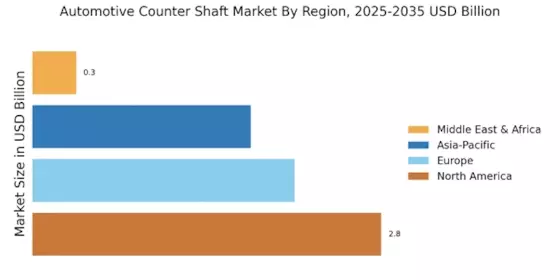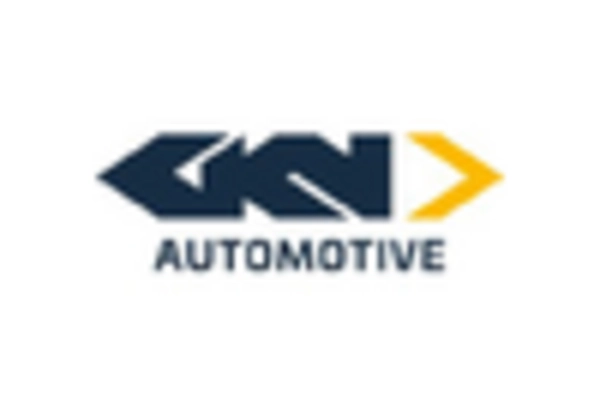Growth in Automotive Production
The Automotive Counter Shaft Market is benefiting from the overall growth in automotive production. With an increase in vehicle manufacturing, the demand for essential components, including counter shafts, is on the rise. Recent statistics indicate that global vehicle production has reached approximately 90 million units annually, creating a substantial market for automotive parts. This growth is driven by rising disposable incomes and urbanization, leading to higher vehicle ownership rates. As manufacturers ramp up production to meet this demand, the Automotive Counter Shaft Market is likely to expand, presenting opportunities for suppliers and manufacturers alike.
Rising Popularity of Hybrid Vehicles
The Automotive Counter Shaft Market is witnessing a shift in consumer preferences towards hybrid vehicles. As hybrid technology gains traction, the demand for components that support these systems, including counter shafts, is likely to increase. Hybrid vehicles require specialized transmission systems that can efficiently manage both electric and internal combustion power sources. This trend is supported by data indicating that hybrid vehicle sales have increased by over 20% in recent years. Consequently, the Automotive Counter Shaft Market must adapt to these changes, focusing on developing counter shafts that cater to the unique requirements of hybrid systems.
Increasing Demand for Fuel Efficiency
The Automotive Counter Shaft Market is experiencing a notable surge in demand for fuel-efficient vehicles. As consumers become more environmentally conscious, manufacturers are compelled to innovate and enhance the efficiency of their vehicles. Counter shafts play a crucial role in the transmission system, directly impacting fuel consumption. According to recent data, vehicles equipped with advanced counter shaft designs can improve fuel efficiency by up to 15%. This trend is likely to drive investments in research and development, as companies strive to meet regulatory standards and consumer expectations. Consequently, the Automotive Counter Shaft Market is poised for growth as manufacturers seek to optimize performance while minimizing environmental impact.
Regulatory Pressure for Emission Standards
The Automotive Counter Shaft Market is significantly impacted by regulatory pressures aimed at reducing vehicle emissions. Governments worldwide are implementing stringent emission standards, compelling manufacturers to innovate and enhance the efficiency of their vehicles. Counter shafts, being integral to the transmission system, play a vital role in achieving these standards. Data suggests that vehicles with optimized counter shafts can reduce emissions by up to 10%. As manufacturers strive to comply with these regulations, the Automotive Counter Shaft Market is likely to see increased demand for advanced counter shaft technologies that facilitate lower emissions and improved performance.
Technological Innovations in Transmission Systems
Technological advancements in transmission systems are significantly influencing the Automotive Counter Shaft Market. Innovations such as dual-clutch transmissions and continuously variable transmissions are becoming increasingly prevalent, necessitating the development of specialized counter shafts. These innovations enhance vehicle performance and efficiency, which is crucial in a competitive market. The integration of smart technologies, such as electronic control units, further optimizes the functionality of counter shafts. As these technologies evolve, the Automotive Counter Shaft Market is expected to adapt, leading to new product offerings and improved performance metrics.


















Leave a Comment